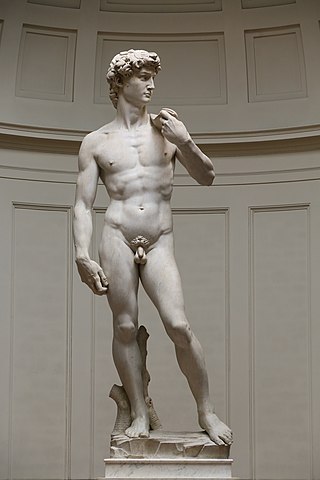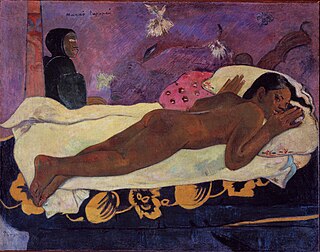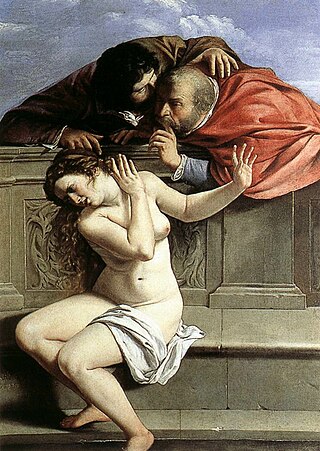
Suzanne Valadon was a French painter who was born Marie-Clémentine Valadon at Bessines-sur-Gartempe, Haute-Vienne, France. In 1894, Valadon became the first woman painter admitted to the Société Nationale des Beaux-Arts. She was also the mother of painter Maurice Utrillo.

Erotic art is a broad field of the visual arts that includes any artistic work intended to evoke erotic arousal. It usually depicts human nudity or sexual activity, and has included works in various visual mediums, including drawings, engravings, films, paintings, photographs, and sculptures. Some of the earliest known works of art include erotic themes, which have recurred with varying prominence in different societies throughout history. However, it has also been widely considered taboo, with either social norms or laws restricting its creation, distribution, and possession. This is particularly the case when it is deemed pornographic, immoral, or obscene.

Olympia is a painting by Édouard Manet, first exhibited at the 1865 Paris Salon, which shows a nude woman ("Olympia") lying on a bed being brought flowers by a servant. Olympia was modelled by Victorine Meurent and Olympia's servant by the art model Laure. Olympia's confrontational gaze caused shock and astonishment when the painting was first exhibited because a number of details in the picture identified her as a prostitute. The French government acquired the painting in 1890 after a public subscription organized by Claude Monet. The painting is on display at the Musée d'Orsay, Paris.

An art model poses, often nude, for visual artists as part of the creative process, providing a reference for the human body in a work of art. As an occupation, modeling requires the often strenuous 'physical work' of holding poses for the required length of time, the 'aesthetic work' of performing a variety of interesting poses, and the 'emotional work' of maintaining a socially ambiguous role. While the role of nude models is well-established as a necessary part of artistic practice, public nudity remains transgressive, and models may be vulnerable to stigmatization or exploitation. Artists may also have family and friends pose for them, in particular for works with costumed figures.

Feminist art is a category of art associated with the late 1960s and 1970s feminist movement. Feminist art highlights the societal and political differences women experience in their lives. The hopeful gain from this form of art is to bring a positive and understanding change to the world, in hope to lead to equality or liberation. Media used range from traditional art forms such as painting to more unorthodox methods such as performance art, conceptual art, body art, craftivism, video, film, and fiber art. Feminist art has served as an innovative driving force towards expanding the definition of art through the incorporation of new media and a new perspective.
Émilie Charmy was an artist in France's early avant-garde. She worked closely with Fauve artists like Henri Matisse, and was active in exhibiting her artworks in Paris, particularly with Berthe Weill.

Nude photography is the creation of any photograph which contains an image of a nude or semi-nude person, or an image suggestive of nudity. Nude photography is undertaken for a variety of purposes, including educational uses, commercial applications and artistic creations. The exhibition or publication of nude photographs may be controversial, more so in some cultures or countries than in others, and especially if the subject is a minor.

The nude, as a form of visual art that focuses on the unclothed human figure, is an enduring tradition in Western art. It was a preoccupation of Ancient Greek art, and after a semi-dormant period in the Middle Ages returned to a central position with the Renaissance. Unclothed figures often also play a part in other types of art, such as history painting, including allegorical and religious art, portraiture, or the decorative arts. From prehistory to the earliest civilizations, nude female figures are generally understood to be symbols of fertility or well-being.

In critical theory, sociology, and psychoanalysis, the gaze, in the philosophical and figurative sense, is an individual's awareness and perception of other individuals, other groups, or oneself. The concept and the social applications of the gaze have been defined and explained by existentialist and phenomenologist philosophers. Jean-Paul Sartre described the gaze in Being and Nothingness (1943). Michel Foucault, in Discipline and Punish: The Birth of the Prison (1975), developed the concept of the gaze to illustrate the dynamics of socio-political power relations and the social dynamics of society's mechanisms of discipline. Jacques Derrida, in The Animal That Therefore I Am (1997), elaborated upon the inter-species relations that exist among human beings and other animals, which are established by way of the gaze.

Spirit of the Dead Watching (Manao tupapau) is an 1892 oil on burlap canvas painting by Paul Gauguin, depicting a nude Tahitian girl lying on her stomach. An old woman is seated behind her. Gauguin said the title may refer to either the girl imagining the ghost, or the ghost imagining her.

André Utter was a French painter. He was born in the 18th arrondissement of Paris to parents of Alsatian origin. He is best known for having been the second husband and manager of French painter Suzanne Valadon and the step-father of her son, Maurice Utrillo. The trio have also been called the trinité maudite because of their quarrels, reconciliations, and alcoholism.

The Blue Room is a 1923 oil-on-canvas painting by French artist Suzanne Valadon. One of her most recognizable works, it has been called a radical subversion of the traditional female nude in art. Like many of Valadon's later works, it uses strong colors and emphasizes decorative backgrounds and patterned materials. Valadon uses these techniques among others to create a full portrayal of her female subject relevant to her social era—moving her value away from solely being related to her physical attributes. As a whole, Valadon's artistic decisions create an image of a modern 20th century woman—contrasting the depictions created by her predecessors and leaving a legacy for future female artists.
Fine art nude photography is a genre of fine-art photography which depicts the nude human body with an emphasis on form, composition, emotional content, and other aesthetic qualities. The nude has been a prominent subject of photography since its invention, and played an important role in establishing photography as a fine art medium. The distinction between fine art photography and other subgenres is not absolute, but there are certain defining characteristics.

In feminist theory, the male gaze is the act of depicting women and the world in the visual arts and in literature from a masculine, heterosexual perspective that presents and represents women as sexual objects for the pleasure of the heterosexual male viewer. In the visual and aesthetic presentations of narrative cinema, the male gaze has three perspectives: (i) that of the man behind the camera, (ii) that of the male characters within the film's cinematic representations; and (iii) that of the spectator gazing at the image.
The female gaze is a feminist theory term referring to the gaze of the female spectator, character or director of an artistic work, but more than the gender it is an issue of representing women as subjects having agency. As such all genders can create films with a female gaze. It is a response to feminist film theorist Laura Mulvey's term "the male gaze", which represents not only the gaze of a heterosexual male viewer but also the gaze of the male character and the male creator of the film. In that sense it is close, though different, from the Matrixial gaze coined in 1985 by Bracha L. Ettinger. In contemporary usage, the female gaze has been used to refer to the perspective a female filmmaker (screenwriter/director/producer) brings to a film that might be different from a male view of the subject.
Le déjeuner sur l'herbe: les trois femmes noires is a massive painting created by the African-American visual artist Mickalene Thomas. The painting is both a critique of and reference to Édouard Manet's 1863 painting Le Déjeuner sur l'herbe. Thomas' piece portrays three bold, black women adorned with rich colors, patterned clothing, and radiant Afro-styled hair; the women's positioning and posing is reminiscent of the subjects of Manet's piece, but the gazes of all three women are fixed on the viewer. Thomas created the painting, her largest piece at the time, in 2010 after being commissioned by the Museum of Modern Art (MoMA) in New York City to create a display piece for 53rd street window of the museum's restaurant The Modern.

Susanna and the Elders is an Old Testament story of a woman falsely accused of adultery after two men who, after discovering one another in the act of spying on her while she bathes, conspire to blackmail her for sex. Depictions of the story date back to the 9th century, but were infrequent until the Renaissance.

Casting the Net is an oil-on-canvas painting by French artist Suzanne Valadon, executed in 1914. It has the dimensions of 201 by 301 cm. It is held in the collection of the Museum of Fine Arts in Nancy.

The Abandoned Doll is an oil-on-canvas painting executed in 1921 by French artist Suzanne Valadon. It has the dimensions of 135 by 95 cm. It is held at the National Museum of Women in the Arts, in Washington, D.C.

Adam and Eve is an oil-on-canvas painting by French artist Suzanne Valadon, executed in 1909. Its dimensions are 162 by 131 cm. It is held at the Centre Georges Pompidou, in Paris.
















